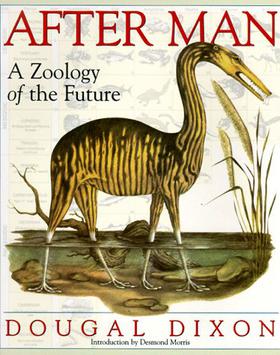Dougal
Dixon's "After Man" is an entertaining evolutionary fantasy. Dixon
wonders how the world will look like 50 million years into the future. His
scenario is actually quite simple: humanity have disappeared after first
killing off most specialized animal species. Naturally, farm animals such as
pigs and cows also die out shortly after humanity. After millions of years, the
near-empty world is filled with new creatures, descended from animals humanity
regarded as pests: rats, rabbits, starlings, crows and the mongoose. Humans
never managed to eradicate them, and free from human interference they evolve
into countless new species.
"After Man" is really a book about evolution. Indeed, the first chapters aren't about the future, but about Earth's evolutionary past and present. I think Dixon's wanted to educate the public about evolution and its mechanisms, and realized that a fanciful book about possible future animals would sell better than yet another dry tome about Neandertals or selfish genes. At least in terms of sales figure, Dixon was successful.
Here in Sweden, "After Man" was heavily promoted by Swedish media in 1982, when the Swedish translation was published. I believe they even mentioned the book on the national evening news! I also remember that the book was extremely expensive, and that my father really hated it. (He sounded like the negative customer reviewer T.Peoples on this product page.) In my father's opinion, Dixon's book was ridiculous and too speculative, and for some reason he particularly hated the Horrane, in the belief that it was a hybrid tiger of some sort. Still, I managed to talk my parents into buying me a copy. Incidentally, the name of the fantasy animals are really silly in the Swedish translation. They often sound frivolous, and I suspect many Swedes bought the book for the comic effect, which is considerable. Thus, the bat (fladdermus) has been turned into a gibberish mouse (pladdermus), and the puffin (lunnefågel) is morphed into a moody bird (lynnefågel). The original English names, all things considered, are more normal!
What makes "After Man" so compelling is that the book isn't *that* speculative and far-fetched. Most of the evolutionary changes conjured up by Dixon are perfectly believable, even a bit conservative. Many of his futuristic animals are simply "improved" versions of present animals: beavers that are more efficient swimmers, bats with even better eco-location, and brood parasitic magpies. Dixon's main idea - that animals like rabbits, rats or starlings will survive humanity - isn't very far-fetched either. In Dixon's post-human world, rabbits have evolved into large, deer-like creatures, rats have turned into wolfish predators, and the birds of prey turn out to be strong-billed starlings. More fanciful, perhaps, is the Vortex, a whale-like creature that's actually a highly evolved penguin! The least believable chapter takes us to Batavia, an imaginary group of volcanic islands in the Pacific where bats have evolved into monsters. But then, 50 million years is a very long time... I remember that Swedish media were particulary fascinated by the Night Stalker.
I haven't read Dixon's later works, but apparently he left moderation behind, becoming more of a science fiction writer. Nothing wrong with that. Still, I prefer the clever evolutionary fantasies of "After Man".

No comments:
Post a Comment